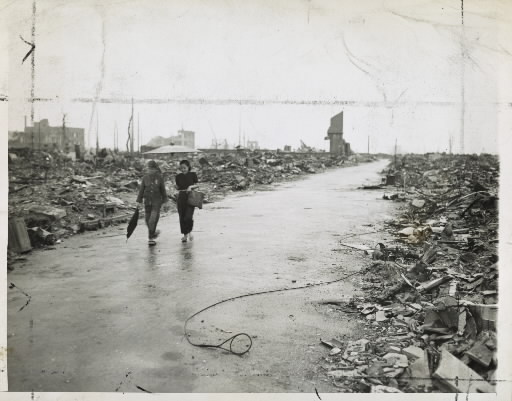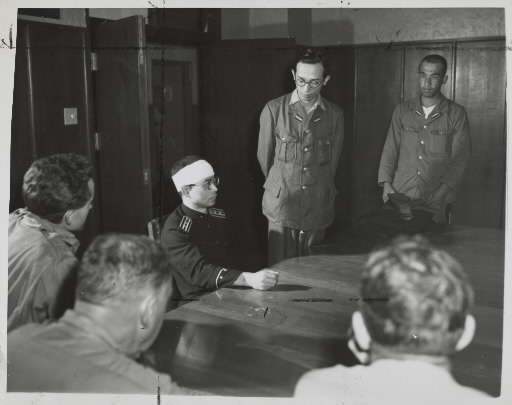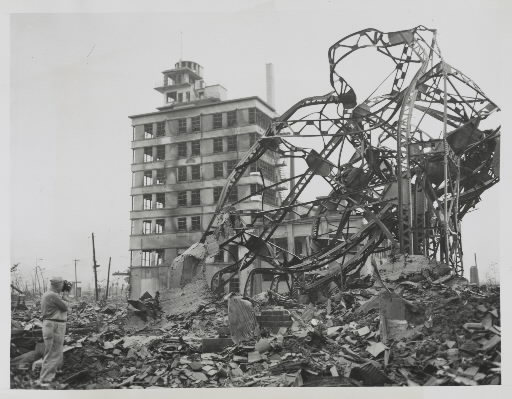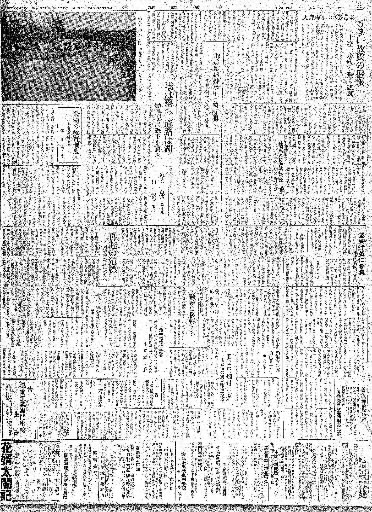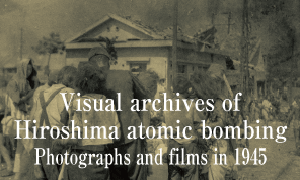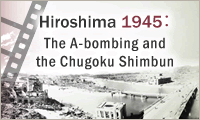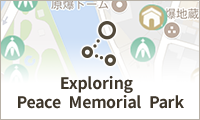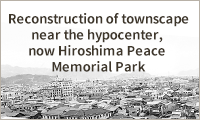Special 120th anniversary series: The A-bombing and the Chugoku Shimbun (Part 6)
May 10, 2012
News coverage and another disaster
by Masami Nishimoto, Senior Staff Writer
Fumbling efforts to convey A-bombing’s effects
The offices of the Chugoku Shimbun were destroyed by fire with the dropping of the atomic bomb on Hiroshima on August 6, 1945. Using a rotary printing press that had been taken to the village of Nukushina on the outskirts of the city (now Higashi Ward), the company resumed printing the paper itself with the September 3 edition. Coincidentally, that same day a group of reporters traveling with the U.S. military arrived in Hiroshima. Five days later a U.S. military A-bomb survey team arrived. It was rumored that “no living thing would be able to live” in Hiroshima. What sort of coverage did the A-bombed news outlet provide? In this article the Chugoku Shimbun examines the initial reporting on the atomic bombing in Japan and the United States.
Publication halted again by typhoon
An article at the top of page 2 of the September 5 edition of the Chugoku Shimbun said, “The power of the atomic bomb, which was an important factor in bringing this war to a conclusion, and Hiroshima, the first place to be ravaged by the atomic bomb, are now the focus of attention of the world along with the Occupation forces.” The article told of the September 3 arrival in Hiroshima of a group of American reporters and described a meeting with Hirokuni Dazai, head of the prefecture’s special political police section, and reporters who covered the prefectural government.
Exchange of views with American reporters
The article also provides a record of the first exchange of opinions between citizens of Japan and the United States on the dropping of the atomic bomb. The principal exchange of questions and answers between the participants went as follows:
Prefectural government reporters: How did you feel when you saw the devastation of Hiroshima?
American reporters: We accompanied U.S. military forces to the front lines in Europe and the Pacific, but the destruction of Hiroshima was the most extensive of any city.
Prefectural government reporters: Is it true that for 75 years no people or living things will be able to live in areas where the atomic bombs were dropped?
American reporters: This will become clear when scholars from the U.S. come and investigate. Right now we don’t know anything.
The group of about 20 members included reporters from influential news outlets such as the New York Times, the Associated Press and United Press International as well as U.S. military press officers and second-generation Japanese-American interpreters. The group traveled to Hiroshima from Atsugi Airfield via Kure and walked around the hypocenter area.
The meeting took place at the prefectural offices, which had been relocated to Toyo Kogyo (now Mazda) in Fuchu-cho. Ichiro Osako, then 32 and a news reporter for the Chugoku Shimbun, attended. In “Hiroshima 1945,” a series of articles published in the evening edition of the Chugoku Shimbun in 1975, he described his colleagues from the victorious U.S., who were the first Americans to come to Hiroshima after the A-bombing.
“They were wearing nice clothes and had top-quality photographic equipment and movie cameras. In contrast, we were dressed in shabby national uniforms, rubber-soled cloth footgear and gaiters, and no one had a camera.” The atomic bombing had left Mr. Osako feeling weary.
The “75 years” that the prefectural government reporters asked about arose from a view stated immediately after the A-bombing of Hiroshima by Dr. Harold Jacobson, who had worked on the plan to develop the atomic bomb.
The August 8 edition of the Atlanta Constitution stated, “Actually, tests have shown that the radiation in an area exposed to the force of an atomic bomb will not be dissipated for approximately 70 years. Hence, Hiroshima will be a devastated area not unlike our conception of the moon for nearly three-quarters of a century.” This report was distributed by U.S. wire services.
Dr. Jacobson’s view reached Japan as well, and a headline in the August 23 Osaka edition of the Mainichi Shimbun said, “Area will be uninhabitable for 70 years; ruins of Hiroshima, Nagasaki relics of the war.” This report was conveyed to Hiroshima when the article was carried in the August 27 edition of the Chugoku Shimbun, which was printed at the western Japan offices of the Mainichi Shimbun.
Three years after the atomic bombing, Toyofumi Ogura, then 46 and an associate professor at Hiroshima University of Literature and Science, wrote about the tremendous impact of Dr. Jacobsen’s statement in “Letters from the End of the World: A Firsthand Account of the Bombing of Hiroshima,” which was translated into English. “There were no instructions or warnings from the Japanese authorities, so it was inevitable that anxiety, fear and false rumors spread,” he wrote.
How did the first American reporters to come to Hiroshima react to the atomic bombing? A search of the New York Times website uncovered an article by W.H. Lawrence that appeared on the front page of the paper’s September 5, 1945 edition.
Mr. Lawrence’s report included the following statements: “The atomic bomb still is killing Japanese at a rate of 100 daily.” “The stench of death still pervades and survivors or relatives of the dead, wearing gauze patches over their mouths, still probe among the ruins for bodies or possessions.” “It was predicted the final count would exceed 80,000 dead.”
The reporters who saw the devastation could not overlook the brutality of the atomic bomb or the effects of radiation. But with the arrival in Hiroshima of the Manhattan District Survey Team, the tone of coverage in the U.S. completely changed.
On September 8 a survey team led by Brig. Gen. Thomas Farrell, who had been the second-ranking official on the Manhattan Project for the development of the atomic bomb, arrived in Hiroshima via Iwakuni. The General Headquarters of the Allied Forces (GHQ) instructed the Japanese government to cooperate, and Masao Tsuzuki, then 52 and a professor in the faculty of medicine at Tokyo Imperial University, accompanied the team. Prof. Tsuzuki was a leading expert in the field of radiology and the first to make a diagnosis of “atomic bomb syndrome” in the case of Midori Naka. Ms. Naka, then 35 and a member of a Shingeki traveling theater troupe, was exposed to the A-bombing in rental housing in Hiroshima. She returned to Tokyo and died there on August 24 in the hospital affiliated with Tokyo Imperial University.
General repudiates “75-year theory”
On September 9 the survey team viewed the devastation from the ruins of Hiroshima Castle. The team measured the residual radiation at the bombing’s hypocenter and began preliminary surveys at Hijiyama National School (Minami Ward) and the Hiroshima Red Cross Hospital (Naka Ward), where injured people were being housed.
Under a four-deck headline that said “75-year theory a lie,” the September 10 edition of the Chugoku Shimbun carried a comprehensive report saying, “Allied atomic bomb survey team arrives in Hiroshima.”
Prof. Tsuzuki posed this question to Gen. Farrell: “It has been reported that the toxins in the atomic bomb will remain potent for 75 years…but what do you think?” He referred to this as “what the citizens of Hiroshima most want to know.” According to the article, when asked this question the general immediately replied, “Seventy-five years is ridiculous. The bomb…won’t have any effect after two or three days.”
Gen. Farrell returned to Tokyo and gave a press conference on September 12, which was covered in the September 13 edition of the New York Times under a headline saying “No Radioactivity in Hiroshima Ruin.” The article said, “He said his group of scientists found no evidence of continuing radioactivity in the blasted area…and it was his opinion that there was no danger to be encountered by living in the area at present.”
Immediately after the dropping of the atomic bomb the U.S. military began to deny the existence of residual radiation or any effects of radiation. In subsequent research studies the military stated that induced (residual) radiation in the soil was believed to have fallen to a level that would have no effect on people by two weeks after the dropping of the bomb. However the studies stated that the effects of internal exposure to radiation, such as by drinking water, remained unclear.
According to documents related to the occupation of Japan in the collection of the Politics and Parliamentary Affairs Division of the National Diet Library, on September 9 Gen. Farrell sent a report to the U.S. in which he stated, “Warren and party have examined ten anemic and epilated patients and also shown low blood counts as reported to you.” But these findings were not made public in order to maintain confidentiality about the atomic bomb.
Initially, patients with blood in their stool as the result of the effects of radiation were diagnosed by medical institutions as having dysentery and quarantined, according to the memoirs of Ayao Koyama, a doctor who participated in the relief effort at the Hiroshima Communications Hospital just after the bombing. Neither the government nor the public was knowledgeable about radioactivity, so they had no choice but to believe what the U.S. military and experts said.
The Chugoku Shimbun suggested home remedies for the effects of radiation, about which nothing was known, citing the effectiveness of squash in its September 4 edition and moxibustion in its September 8 edition. The September 6 edition said, “Recovery starts with hot drinks for the public” and carried a report on a coffee shop that had opened in the city’s Asano Library, which had survived the bombing. The article was accompanied by a photograph. Both treatments for the effects of radiation and news coverage began with fumbling efforts.
Local notices in advertising columns
In its September 10 edition the paper reported the arrival of Dr. Marcel Junod, then 41 and head of the Japan delegation of the International Red Cross, who accompanied the survey team and brought with him “15 tons of relief and medical supplies” to the city. The article reported that Dr. Junod said in an interview, “We must work to ensure that the atomic bomb is never used again.”
Shinichi Kato, then 44 and manager of the paper’s news department, served as both interpreter and guide for Dr. Junod. “I was asked by the prefecture to help out. I rode all over the city with him by Jeep,” Mr. Kato wrote in a document appended to his 1967 application for an A-bomb survivor’s certificate. The following day, September 11, the paper carried an article on the survey team by Rihei Numata, then 43 and head of the paper’s Itsukushima bureau.
Both Mr. Kato and Mr. Numata had gone to the U.S. as teenagers and had worked as editors at Beikoku Sangyo Nippo, a Japanese-language newspaper published in Los Angeles, according to a history of Japanese in Southern California published in 1957. In 1940, the year before the outbreak of war between Japan and the U.S., Mr. Numata returned to Japan. Mr. Kato returned on the first repatriation ship from the U.S. to Japan in 1942 following the start of the war.
With resumption of publication by the Chugoku Shimbun itself, local notices were carried in the paper’s advertising columns. In the September 5 edition the Hiroshima prefectural government called on its employees and the families of employees who had died to contact their offices immediately. An “urgent notice” about the licensed red-light district appeared in the same edition under the names of various unions and the chiefs of the Higashi and Nishi police stations. Joint memorial services were also announced, including those for Hiroshima Gas, the Hiroshima Electric Railway Company, Yutani Heavy Industries, Toyo Kogyo and Hiroshima Jogakuin College.
In its September 4 edition the Chugoku Shimbun reported the names of employees who had died. “Thus far it has been ascertained that 59 of the company’s employees have died in the war,” the paper said. Starting on September 6 the paper ran advertisements every day urgently seeking employees. Production of the paper in Nukushina, where the Chugoku Shimbun had resumed publishing the paper itself, continued to walk a tightrope as power shortages kept the rotary printing press from running properly.
Then an unprecedented storm, the Makurazaki Typhoon, hit the Hiroshima area on September 17. According to a prefectural record of landslide damage published in 1997, 2,012 people were killed, primarily along the coast.
An article headlined “Typhoon hits Hiroshima Prefecture; bridges collapse, roads turn to lakes” was accompanied by a photograph with a caption saying, “Villagers battle flooding.” The article appeared in the September 18 edition of the Chugoku Shimbun, the last to be printed in Nukushina. Publication had been halted by a disaster yet again.
(Originally published on April 28, 2012)
Special 120th anniversary series: The A-bombing and the Chugoku Shimbun (Part 7)

